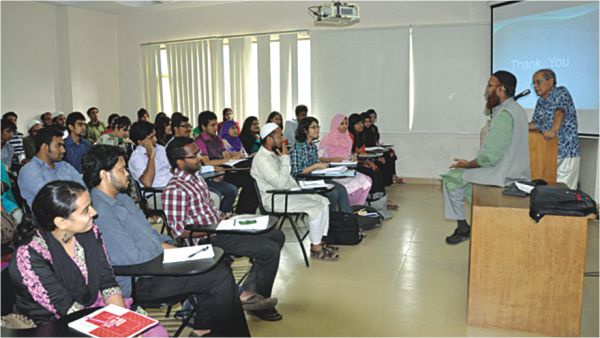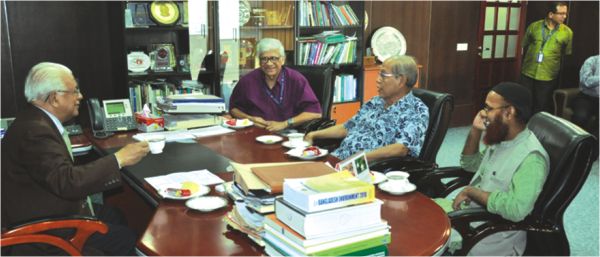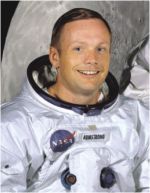After Class
IML Presidential Discourse
Rumana Fouzia Choudhury
The former President of Bangladesh, Professor Dr AQM Badruddoza Chowdhury, conducted an open-to-all IML Discourse I lecture on “Language and Development” on June 17, 2012 at North South University (NSU). He paid his first visit to NSU in 2002 when he was the President, and now, 10 years later, Professor B Chowdhury returned to NSU as a member of the Institute, for the high-profile lecture series of NSU which is called IML Discourse I. The lecture was attended by a group of enthusiastic students of NSU, University of Dhaka, and BUET.

Professor AQM Badruddoza Chowdhury, former President of Bangladesh, addressing the students.
Courtesy: NSU
At the beginning of the event, Head of Institute, Mohammed Shahedul Haque, pointed out that there was an inevitable relationship between language and development of a nation, because development depends on conceptualisation and implementation of political, societal, and economic transformations which come from knowledge. Acquisition, dissemination and application of knowledge, he said, depends on communication, and thus 'language', the primary means of communication, enters into a relationship with the development of a nation.
In his lecture the former President discussed the development of language through education. He said that language is enhanced and enriched by poets and writers, and novelists, and it is by reading this great body of literature that one can reach the heart of language, and thus, the heart of a culture and the people. Language, he said, is deeply interwoven with culture, and national development is impossible without the careful application of appropriate knowledge and knowledge requires language and communication to survive and reach people at all levels. Hence, language and development are inseparable entities.

Professor AQM Badruddoza Chowdhury, Mohammed Shahedul Haque and Dr Khalequzzaman
Elias having a chat with the VC of NSU, Dr Hafiz G A Siddiqi. Courtesy: NSU
Regarding education in Bangladesh, the former Head of State said that in Bangladesh, the education systems are 'grossly confused'. First of all, ours is a unique nation with people learning three languages representing three civilisations. A literate Bangladeshi knows Bangla, his mother tongue, fluently; he has some competence in English, and also in Arabic. He can recite from the Holy Quran, but unfortunately often without making reference to the implications that can develop his personality morally and spiritually. He laments over the state of education, mainly because, despite having a grasp in English, most of the Bangladeshi people have not been moved by the magic of Shakespeare, and when we pray and recite in pure Arabic, we do not even always understand what we are saying, and the former President finds this to be very sad.
After his lecture, he opened the floor to the students to ask questions. He inspired all the students to learn more than two languages as every language is useful as well as beautiful. His discourse became the most unforgettable class for the audience as the former President responded to their enthusiastic questions with utmost patience and interest.
(The author is an English Major at NSU.)
DID YOU KNOW?
Neil Armstrong
 |
|
Astronaut Neil Armstrong was born in Wapakoneta, Ohio on the 5th of August, 1930 (today is his 82nd birthday). His love for flying grew when his family had to move from state to state for his father's job, having gotten off to an early start when his father took 2-year-old Neil to the Cleveland Air Races. On July 20, 1936, when he was 6, he experienced his first airplane flight in Warren, Ohio, when he and his father took a ride in a Ford Trimotor. His father's last move was to Wapakoneta in 1944, where Neil attended Blume High School. Armstrong began taking flying lessons at the county airport, and was just 15 when he earned his flight certificate, before he had a driver's license. Armstrong was active in the Boy Scouts and he eventually earned the rank of Eagle Scout. As an adult, he was recognised by the Boy Scouts of America with their Distinguished Eagle Scout Award and Silver Buffalo Award. In 1947, Armstrong began studying aerospace engineering at Purdue University, where he was a member of Phi Delta Theta and Kappa Kappa Psi. He was only the second person in his family to attend college, and was also accepted to the Massachusetts Institute of Technology (MIT), but the only engineer he knew (who had attended MIT) dissuaded him from attending, telling Armstrong that it was not necessary to go all the way to Cambridge, Massachusetts, for a good education. His college tuition was paid for under the Holloway Plan successful applicants committed to two years of study, followed by three years of service in the United States Navy, then completion of the final two years of the degree. At Purdue, he earned average marks in his subjects, with a GPA that rose and fell during eight semesters. He was awarded a Bachelor of Science degree in aeronautical engineering from Purdue University in 1955, and, from the University of Southern California in 1970, a Master of Science degree in aerospace engineering. Armstrong holds honorary doctorates from a number of universities.
Information Source: Internet.
|
|
|
